In the late 1980s, Gavin Watson built a boat. It wasn’t his first—he had previously built a plywood dinghy and a 16′ fiberglass sailboat of his own design, but it was his largest to-date: a 30′ cold-molded Stratus 927, a racing/cruising sloop designed by the late Alan Warwick. Gavin was living in Connecticut at the time, and during the long construction project, he met Andrea, his wife-to-be, at a country dance. When she learned he was building a boat, Andrea mentioned that she had previously worked as an interpreter at the Small Boat Shop at Mystic Seaport. Gavin’s interest level went up several notches. When the 30-footer was complete, the couple moved aboard.
For a year, they lived a life afloat, but after experiencing the cold Connecticut winter, and dealing with the necessarily limited space, they concluded that they were not meant to be permanent liveaboards, and moved ashore and into a small apartment, which, as Gavin recalls, “seemed absolutely vast.”
When they started a mobile boat-repair business the apartment became unworkable and they moved to a lakeside cottage in Ridgefield, Connecticut. The 30′ sloop was sold, but over the years, other boats were built, including two 22′ trimarans and a 27′ carbon-fiber double kayak.
The Watsons summered on North Haven Island in Maine and, for several years, Gavin, Andrea, and their two children sailed in an F27 trimaran, and later a Maine Cat 30. They explored the local waters and islands of Penobscot Bay and ventured on longer voyages along the coast from Maine to Connecticut.
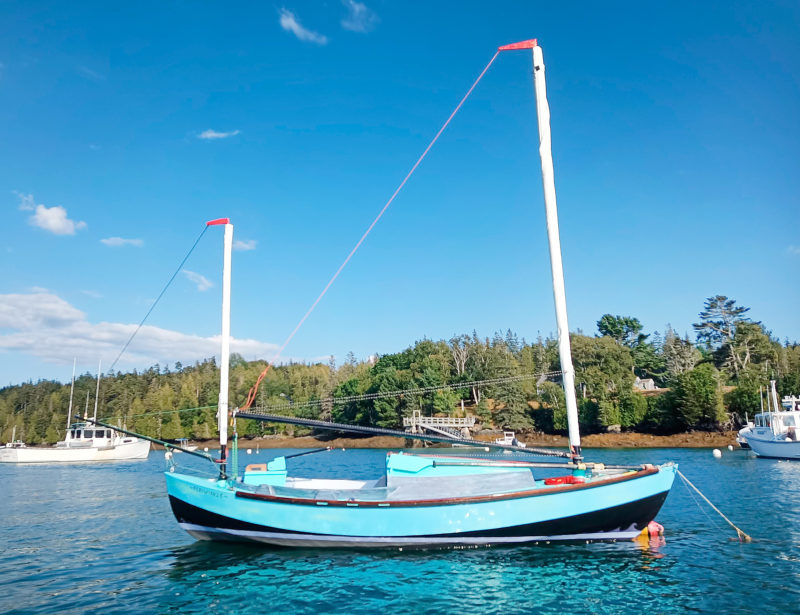 Photographs courtesy of Gavin Watson
Photographs courtesy of Gavin WatsonAdding a mizzen to the Guider’s sail plan gave Gavin the ability to heave-to effectively, a valuable advantage for singlehanded sailing.
Time passed and, as is the way with families, the children grew up, left home, and established their own independent lives. The Maine Cat 30 was sold, and Gavin found himself facing a new reality: “Nobody,” he recalls, “was interested in cruising anymore.” Nobody but him.
As he contemplated other pastimes and browsed the internet looking for inspiration, he happened upon the dinghy-cruising videos of British adventurer, Roger Barnes. He was captivated. “It seemed like a pretty cool way to go,” he says. “If nobody else wanted to do overnights with me, I didn’t really need a big boat. Exploring the nooks and crannies and being able to pull the boat up on a beach looked like a cool idea.” Gavin had found the next step in his boating evolution—he would become a small-boat cruiser.
The coast of Maine is a magical playground for small-boat sailors. According to NOAA, Maine’s coastline is the fourth longest in the country, with almost 3,500 miles of bays, inlets, and island shorelines to explore. In summer, the days are long, the nights cool, and the breezes predictable. For the boat with a shallow draft, there are almost endless numbers of sheltered anchorages and beaches for overnight stays. Gavin was in the right place…all he needed now was the right boat.
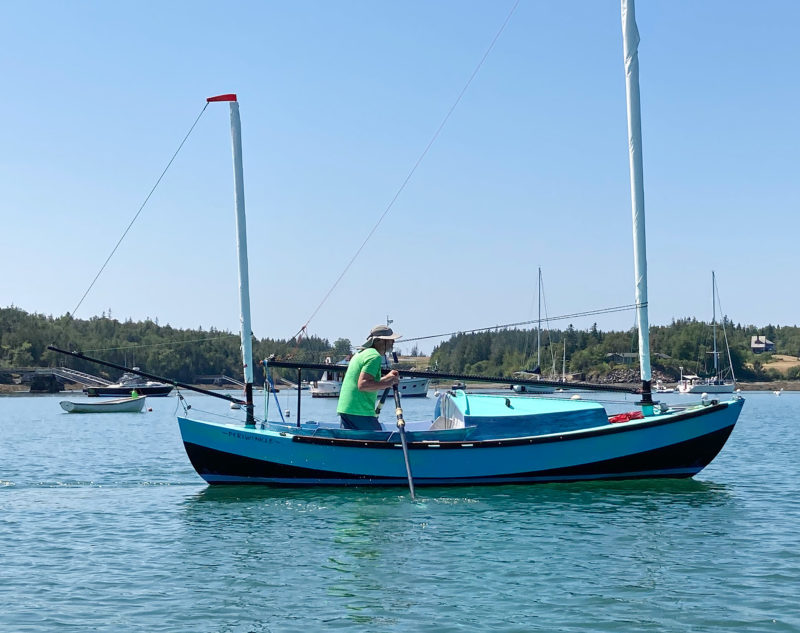
Gavin put two collars on each oar. The inboard collars are placed in the locks for rowing in the conventional manner: seated and facing aft. The outboard collars set the oars at a higher angle for rowing standing up and facing forward, a better method for navigating tight spaces.
He settled on the Guider, a lugsail sail-and-oar cruiser from Chesapeake Light Craft (CLC). At 18′ 9″ LOA with a 6′ beam and minimum draft of 9″, the design seemed ideal for the singlehanded coastal cruising Gavin had in mind. He ordered the kit.
Despite all his previous building experience, Gavin had never before built a kit boat and was unsure how long it would take. He planned to build it through the winter in his two-car garage in Connecticut. But when the kit arrived in early April he couldn’t resist and began “casually working on it.” He was amazed to see it come together with speed. So much so that he soon realized if he continued he would have nothing to occupy the coming winter months. He downed tools and walked away…until October when he began working in earnest.
The Guider is designed to be built stitch-and-glue and CLC recommends the kit to “builders who are already comfortable with epoxy, fiberglass, and stitch-and-glue boatbuilding.” They describe the finished boat as being specifically designed for camp cruising and say that, while the boat is “fast and handy under sail and oar, there’s an emphasis on safety and camp-cruising comfort.”
As designed, the Guider is essentially an open boat with a 6′ 6″-long cockpit. But, perhaps inevitably for someone with as much on-water experience as Gavin, he introduced some modifications.
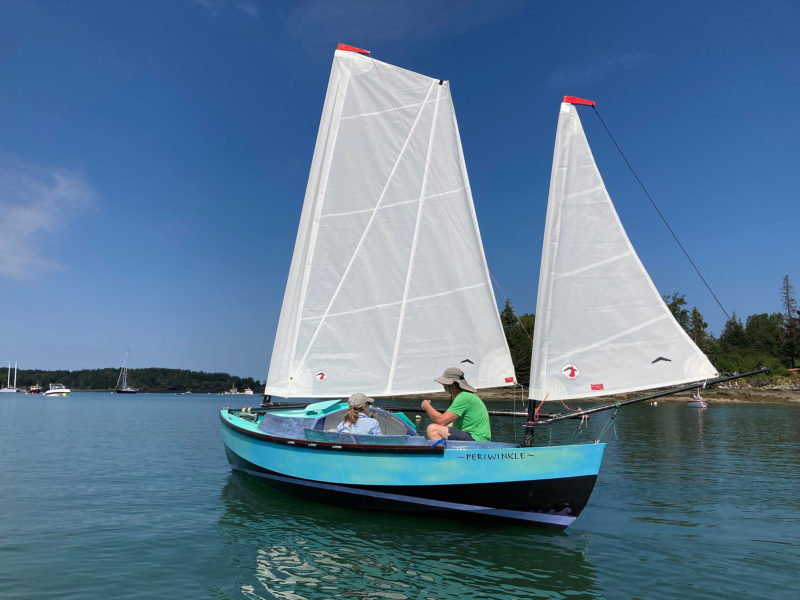
Enamored by the sails of the Norwegian Færder snekker, Gavin opted not to go with the lugsail designed for the Guider, but instead created a roller-furling version of the snekke sail with a flexible fiberglass diagonal batten in lieu of a snekke’s sprit and a similar vertical batten to shape the sail when reefed.
First came the cabin. Influenced by his earlier years of cruising in larger boats, Gavin wanted to be able to “easily crawl in under cover if I arrived in a harbor and the weather was unpleasant. I do have a boom tent, which gives me sitting headroom in the cockpit, but if I want to stay dry, I don’t have to set up the tent.” The cabin addition significantly reduced the size of the cockpit but, says Gavin, there is plenty of room for two adults to sit without getting in each other’s way. The raised cockpit coamings—which he added for protection against water running in off the deck—“are extremely comfortable and the spacing is perfect for bracing my foot against the opposite seatback.” He did raise the seats 4″ to accommodate additional buoyancy.
Other modifications included replacing the ¼″ aluminum centerboard with a larger 165-lb, ½″ stainless-steel one, which increases the boat’s righting moment. He also added 240 lbs of internal lead ballast. CLC recommends 200 lbs (or more if sailing lightly loaded). Gavin kept the general design of the rudder, which, as described by CLC, is “doubtless one of the more controversial features of the new design. Although it complicates the build slightly, designer John C. Harris likes the trunk-rudder for its efficiency and good looks. But most of all, to avoid having to grope awkwardly over the pointed stern to adjust the more typical kick-up rudder.” Gavin increased the rudder’s depth by 3″ and “beefed it up structurally.” He also gave the leading edge a more pronounced angle to encourage “lobster trap lines to slide off”—a significant consideration in Maine waters.
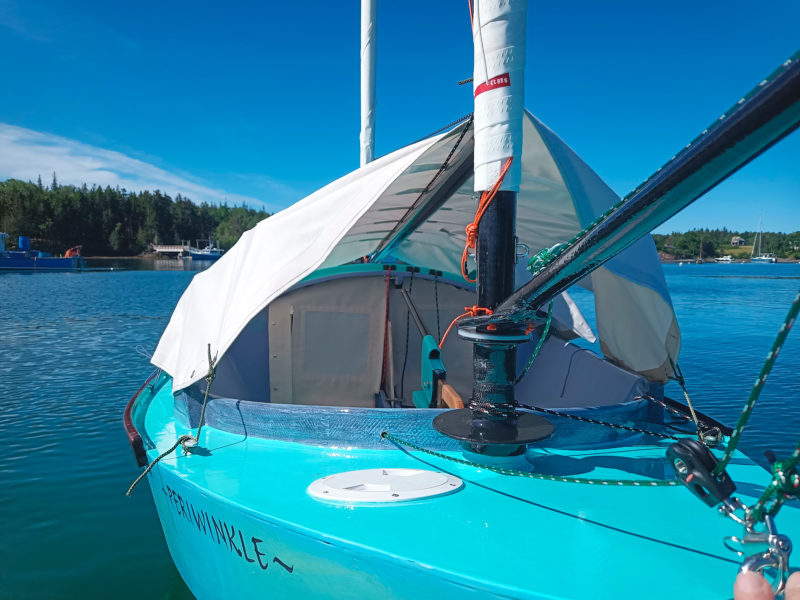
The mizzen’s roller-reefing system is evident here. The boom tent has several battens that create more headroom for sitting on the side benches.
But perhaps the most immediately obvious of Gavin’s alterations was to the rig. In March 2015 Small Boats had published an article on the Færder snekke, a traditional racing workboat from Norway. The class carries a distinctive boomless spritsail and Gavin was impressed by its simplicity, large relative area, and general appearance. For his Guider, he settled on a yawl rig, but the mainsail is a modern interpretation of the sprit rig. “The Færder-snekker rig inspired the shape of my mainsail,” says Gavin. “But I wanted something I could furl very quickly.” Thus, Gavin dispensed with the sprit but gave the sail its highly distinctive shape by introducing two full-length vertical fiberglass battens. The mizzen is a more conventional boomed leg-o’-mutton. Both sails have pocket luffs, slipped over carbon-fiber masts stepped into tubes. The masts rotate on nylon and Teflon bushings, allowing the sails to furl around them.
PERIWINKLE was launched in late June at Pulpit Harbor, a well-protected anchorage on the northwest side of North Haven. Gavin made the maiden outing and sea trials on Penobscot Bay. “I did tests in some rough weather to see how it handled, and I was pleased with it.” The trials also included sleeping aboard. “The first time, it took a bit of getting used to the boat listing to the side I was sleeping on. I am not used to sleeping on a slope, but I eventually got comfortable with it. The second time, I deliberately chose a cold night just to test out what it would be like inside. With the canvas cover on the cabin opening zipped up it was quite comfortable temperature-wise.”
Last fall, Gavin trailered PERIWINKLE back home to Ridgefield and made a few improvements based on the sea trials. He’ll relaunch PERIWINKLE this spring and his new chapter as a solo small-boat cruiser will begin.![]()
Do you have a boat with an interesting story? Please email us. We’d like to hear about it and share it with other Small Boats Magazine readers.


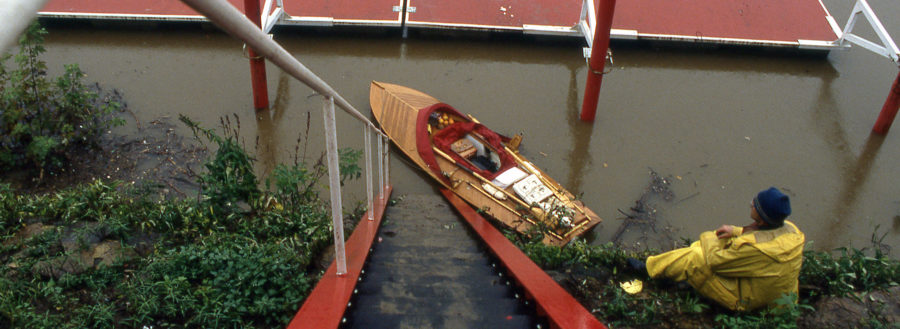
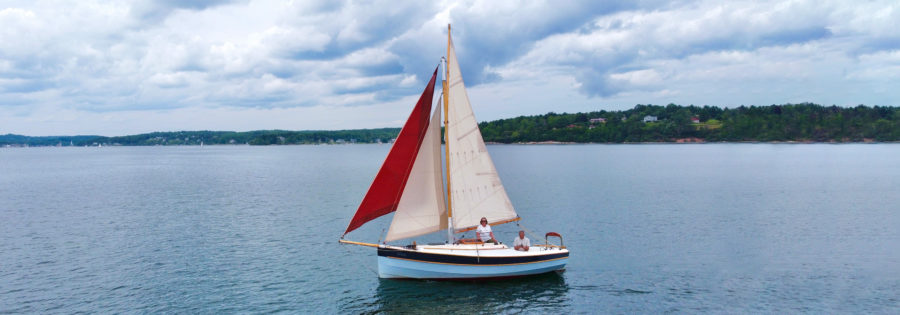

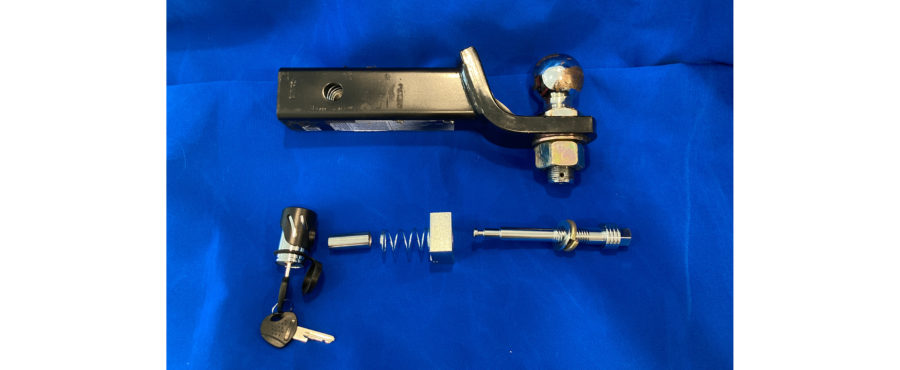
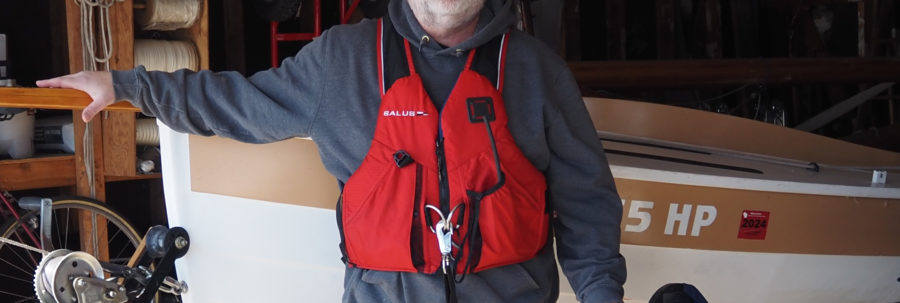

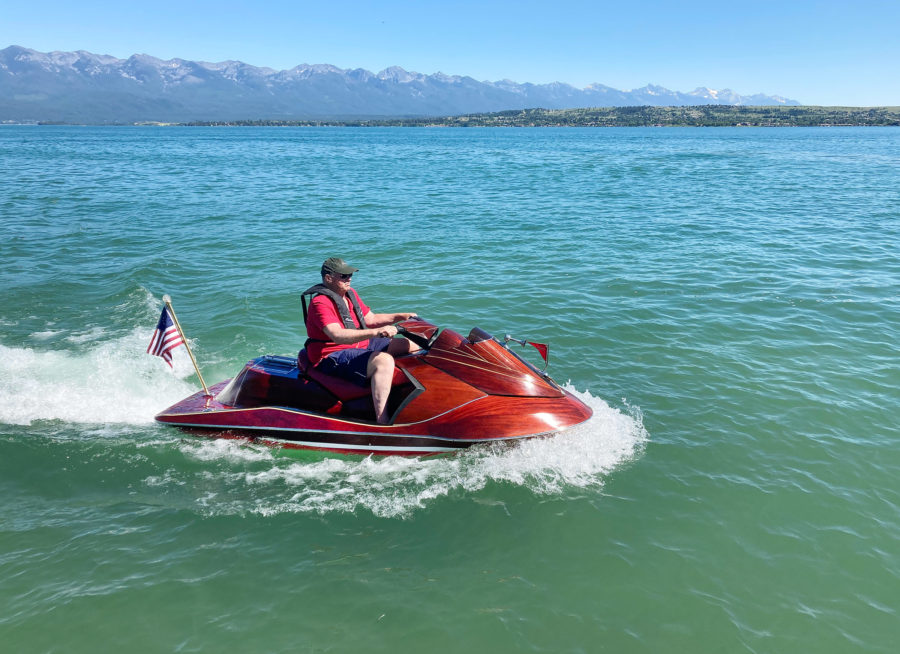
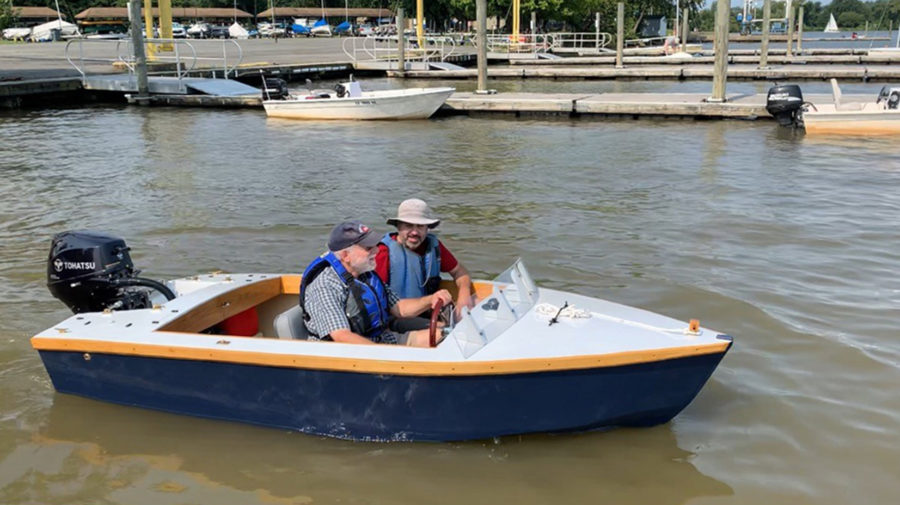
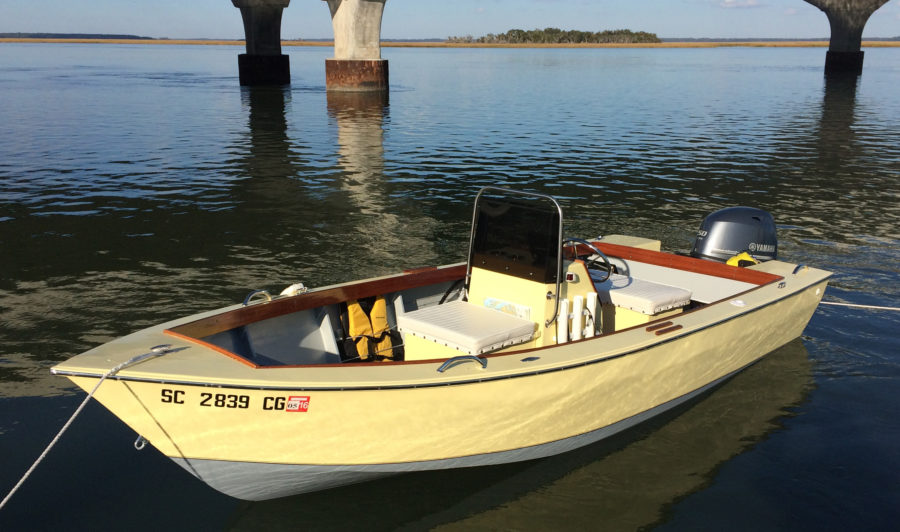
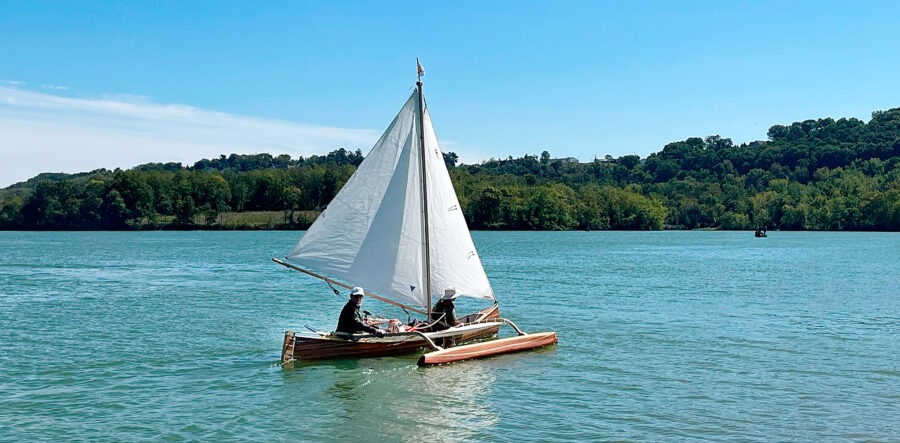
Nice build, Gavin. Particularly like your rig. I’m in the middle of building a 19’ sailboat with a ketch rig and would love to adapt your rig for my use, though a bit smaller. I see you used Rolly Tasker sails. Could you tell where you sourced your carbon-fiber masts and if the roller furlers are of your own design? (Video shows a very smooth deployment.)
Thank you,
Dan
Thanks, Dan. The spars were made by Forte Carbon Spars in Ledyard, Connecticut.
Dan you can see videos of the whole build on my Gavin Watson Youtube channel.
The Dec 2nd one shows the installation of the tubes that the masts fit into. The March 5th and May 28th ones would probably also be useful they show more of how the system works.
Great information, Gavin. Couldn’t have asked for more. Thank you kindly.
I just got a SeaPearl 21, so this boat really captures my attention. Love to see it in person someday, maybe at the WoodenBoat Show this year?
What a very clever interpretation of the Snekke rig, Gavin! I would love to know more about it and have lots of questions, which I hope you won’t mind my asking:
Your flexible fiberglass batten does the work of a much heavier sprit; how much is it aided in holding up the top corner of the mainsail by the presence of the vertical batten?
Is the batten a flat blade section (to be bendy enough to wind around the mast). How thick did you make it?
As the sails have pocket luffs, why don’t the masts just spin inside the pockets when you reef or furl; what did you do to fix the luff to a line along its spar? I can see that the tack of the sail is tied downwards to the mast reefing drum and so will follow round, but what obliges the top of the sail to wind up properly, is it also tied to the mast?
When reefed, does the main set nicely; can you achieve well distributed gathering along the spar, without bagginess in the middle or at one end?
As you are roller furling/reefing onto a tapered spar ; what did the sailmaker have to do to make the reefed sail stand well?
In your videos, I admire the very smooth wake left by the boat, very pretty!
How does she behave at full speed and when reefed?
All the best with the winter season,
Henry in France